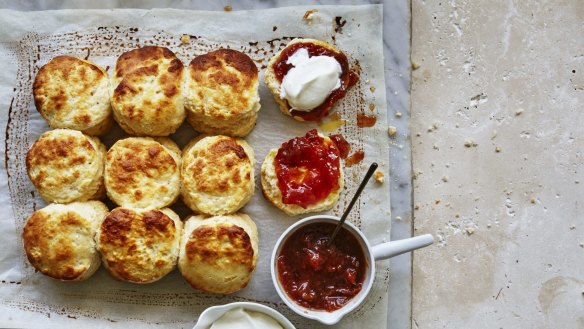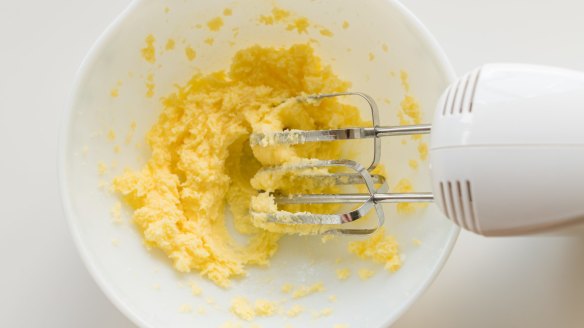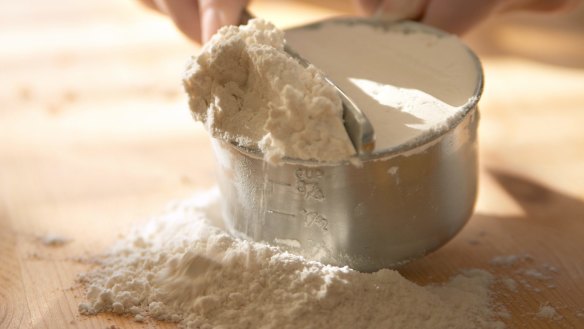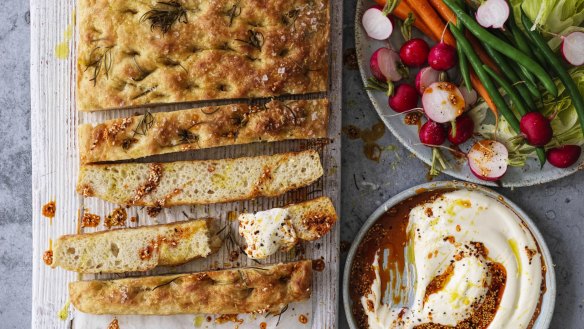Five common baking myths debunked using sugar, science and buttermilk that's not so nice

Like just about anything you may come across online, or even in print, these days, advice about cooking can be a confounding combination of fact, fantasy and outright falsehoods.
Success in the kitchen means looking to trusted sources for recipes and tips. It sometimes means healthy skepticism and often a willingness to test things out yourself. Experience builds knowledge, along with confidence.
If you believed everything you read or heard, you might think that it really is a good idea to cut your onions under running water in your sink (for a variety of reasons, please don't) or that ketchup is a vegetable. But it's the things that are more plausible-sounding that get most of us in trouble. This could be true. This sounds true.
Baking is especially rife with such lore that has taken hold not because it's necessarily accurate but just by sheer repetition.
It's taken stacks of books, years of research, interviews, experiments (I even played with pH strips, see below!) and baking experience to help me sort through the noise.
So I've rounded up a few of the most common baking misconceptions, as well as the ones I know tend to be repeated – and treated as irrefutable fact.

1. Sugar is only for sweetness
Sugar is an integral ingredient in a lot of baking. What does it bring to the table? Sweetness, of course. So for those who say they don't like their desserts too sweet, or who perhaps are looking to cut back on sugar for dietary or medical reasons, the temptation is to start cutting sugar.
This, however, can pose a variety of problems, as sugar does so much more than contribute flavour. Even the flavour is multidimensional, since sugar when cooked creates new flavours through the Maillard reaction (in conjunction with proteins) and caramelisation. Sugar, like salt, works to enhance the flavour of other ingredients such as butter, chocolate, vanilla. It can counteract the more bitter compounds of cocoa and wholemeal flour. What else? Because it attracts water, sugar helps baked goods retain moisture and maintain it. That's especially true in the case of honey or other liquid sweeteners. Breads and cakes made with honey will lose water more slowly than those made with sugar, Harold McGee says in On Food and Cooking.
You also need sufficient sugar for creaming, which "is a mechanical method for creating air bubbles, during which granules of sugar trap air between molecules of fat," Lauren Chattman writes in The Baking Answer Book. Cutting back the sugar lessens the ability to get that air and rise, which is sometimes aided by chemical raising agents (baking soda or powder). In addition to a denser result, you may also end up with a greasier mouthfeel.
Reducing sugar in bread dough can take away the source of food for the yeast and may slow down or impede the rise. You may also end up with flat meringues and similar desserts made with whipped egg whites, where McGee says sugar helps with stability by thickening the mixture and, in the oven, holding onto water until the proteins in the egg whites have set.
When water combines with the protein found in flour, you get gluten, which helps provide structure and chew to baked goods. But sometimes you don't want that, or at least too much of that, which is where sugar's water-attracting skills come in and contribute to tenderness. Remove too much sugar from your recipe, and you may end up with drier biscuits or less plush cake.
If you must bake with less sugar, try starting with small reductions. Or, better yet, seek out recipes developed with these kinds of needs in mind.

2. The measurements you use don't make a difference
When people are dissatisfied with the way something baked – or their baking skills in general – my first question is almost always, "Did you weigh the ingredients?". Using a scale to measure your ingredients goes a long way toward replicating what the recipe developer intended, as well as overall success.
Weight is more precise than volume. How much of an ingredient you get into a dry measuring cup can vary based on how tightly packed the ingredient is, the way you scooped the ingredient (was the flour fluffed up? Did you dip and sweep?) and, as I learned, the measuring cup itself. Even different measuring cups with the same advertised volume can hold different amounts. In baking, even small variations in something like flour or sugar, especially when amplified across multiple cups, can be the difference between a great and a not-so-great baked good.
And how about which unit of weight you use? That matters, too. Bakers vastly prefer grams for a more precise measurement.
3. Salt doesn't matter in baking
As with sugar, it can be easy to think the contribution of salt to baking is limited to salty flavour. In Salt Fat Acid Heat, Samin Nosrat makes a compelling point. "The foundational ingredients of sweets are some of the blandest in the kitchen. Just as you'd never leave flour, butter, eggs or cream unseasoned in a savoury dish, so should you never leave them unseasoned in a dessert. Usually just a pinch or two of salt whisked into a dough, batter or base is enough to elevate the flavours in pie and cookie doughs, cake batters, tart fillings and custards alike."
Salt can help bring other flavours into focus, such as the chocolate in brownies or the corn in cornbread, Chattman says.
McGee explains that salt also lowers the point at which starches gel (absorb water, swell and set), which is crucial in baking.
Salt is essential for properly risen bread. Salt slows down fermentation by dehydrating yeast, Chattman says, which allows for the development of flavourful byproducts from the yeast and bacteria at work. That slow-down lets rising dough have enough time to form gluten. Dough without salt will rise too fast on the bench and then collapse in the oven.
Slowing down yeast activity has another welcome outcome: browning, key to colour and flavour. Yeast thrives on sugar in the dough (it's generated by the breakdown of the flour even if the recipe has no added sugar), and if left unchecked, there would be no sugar left to brown in baking.

4. No-knead bread is not 'real' bread
Here's one that, as an avid bread baker, really makes me want to bang my head against the keyboard. Sharing a recipe for no-knead bread has, on many occasions, elicited comments accusing fans of these minimally mixed breads of being lazy or not making "real" bread.
Wrong. Whether you knead by mixer or by hand or let the dough do all the work, the same thing is happening: the proteins in the flour, when combined with water, bond and cross-link to form the gluten network that will give the bread structure and inflate as the dough proofs and bakes. The first two methods involve active mechanical or manual input, while no-knead recipes take a more passive approach. As Andrew Janjigian, author of the bread-centric Wordloaf newsletter, told me, "Bread dough wants to develop itself." No-knead breads – more like self-kneading, really – typically just require a quick mix in a bowl to bring the ingredients together.
To encourage this process to happen, no-knead recipes tend to be wetter than doughs kneaded other ways. For most people, the difference between a no-knead bread and one mixed with the other methods will be imperceptible when eaten.
5. Milk mixed with acid is a good buttermilk substitute
I make so many pancakes, biscuits, waffles and scones with buttermilk, I am never without it. So it makes me a little bonkers to see the notion treated like gospel that milk doctored with lemon juice or vinegar, is a great substitute for commercial buttermilk.
As Kerry Kaylegian, a food scientist at Penn State who has studied dairy her entire career, told me, buttermilk manufacturers start with milk, add a lactic bacterial culture and let it ferment until the proper flavour and acidity has developed. The thickness may be boosted by dry milk, stabilisers and heat treatment.
To see the differences at work, I made added 1 tablespoon of distilled white vinegar to enough milk to equal 1 cup and let it sit a little more than 10 minutes. The milk was no thicker than when I started, nothing like the cultured option. It smelled and tasted like vinegar, while the thick buttermilk smelled and tasted pleasingly sour. Then I checked the acidity with pH paper strips. Remember, the pH scale ranges from 0 to 14, with lower numbers more acidic. Store-bought buttermilk registered about 5. The vinegared milk registered 6. Why does that matter? The acid reacts with baking soda, the typical raising agent used with buttermilk, to provide lift. Less acid, less rise.
Pancakes made with vinegared milk produced a thin, loose batter that spread more like crepes. While they did rise, they were dwarfed by the buttermilk batch, which boasted a thick, almost scoopable batter. They spread much less in the frypan, resulting in lofty, tender pancakes. Moreover, the vinegared milk batch was bland other than a slightly metallic and tongue-stinging flavour - probably because the reduced acidity meant the baking soda wasn't fully neutralised.
So if a recipe calls for buttermilk, try to stick with it. If you must swap, your best bet, according to Parks, is kefir, followed by plain yoghurt.
The Washington Post
The best recipes from Australia's leading chefs straight to your inbox.
Sign up- More:
- How to